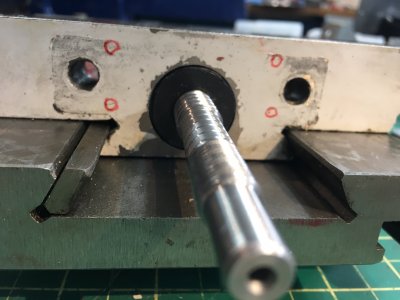slow-poke
Ultra Member
I'm in the middle of replacing the cross feed lead screw with a ballscrew to reduce the backlash. To do so I need to fabricate various mounting blocks to replace the originals. You would think during the design of something like a lathe that if you needed 4 holes in a square pattern to retain say a block you wouldn't randomly choose 9.74mm, when 10mm would easily fit just as well. Further you would not expect to have one of the holes skewed by 0.31mm for no apparent reason.
Moving on, next part with two mounting hole for a flange (image below), one mounting hole drilled 0.1" lower than the other so the flange needs to be tilted to line up with the holes, when it should be level. How does this happen? I imagined these were built on some form of assembly line with CNC machines drilling holes where they should be, not done by some hungover dude with a Black&Decker drill randomly drilling holes by eye.
I'm following drawings from a fellow that did the same upgrade on the supposedly better PM1022 lathe, some of the exact same defects he discovered are present on both lathes, and he has some defects I don't have and I have some defects he doesn't have. Definitely not made in Germany, Japan or Taiwan type quality.
Okay I'm done.

Moving on, next part with two mounting hole for a flange (image below), one mounting hole drilled 0.1" lower than the other so the flange needs to be tilted to line up with the holes, when it should be level. How does this happen? I imagined these were built on some form of assembly line with CNC machines drilling holes where they should be, not done by some hungover dude with a Black&Decker drill randomly drilling holes by eye.
I'm following drawings from a fellow that did the same upgrade on the supposedly better PM1022 lathe, some of the exact same defects he discovered are present on both lathes, and he has some defects I don't have and I have some defects he doesn't have. Definitely not made in Germany, Japan or Taiwan type quality.
Okay I'm done.

